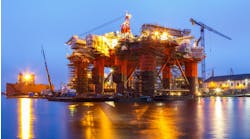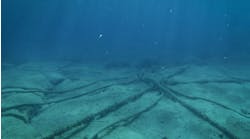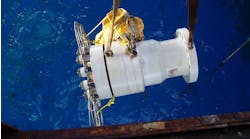While surveying in support of South Stream gas pipeline through the Black Sea, GSP Offshore's DP-2 vesselGSP Prince has set a record for underwater sound velocity.
Onboard personnel took 35 minutes to record an underwater sound velocity profile of a 1,730-m (5,676-ft) deep section. According to GSP Offshore, this beats the previous record for sound velocity profiling of a water column, measuring 1,563 m (5,128 ft) which was held by the National Data Buoy Center in association with the U.S. National Oceanic and Atmospheric Administration.
GSP Prince is equipped for fast recording of underwater sound velocity thanks to its high-speed UnderwaySV winch, developed by Oceanscience (USA), and the RapidSV underwater sound velocity recording profiler supplied by UK-based Valeport.
According to GSP, one innovation to the bottom profiling method used is the application, in tandem with the RapidSV sound velocity rate sensor, of a cantilever-type spool. This makes it possible for the probe to plummet practically in the free-descent mode as the cable unwinds.
The sensor descends through the water at a speed of up to 5 m/sec (16.4 ft/sec) and reaches the depth of 1,000 m (3,281 ft) in three to four minutes. The winch's high wind-up speed allows the sensor to be raised quickly to the surface.
The vessel, working for Russian engineering company PeterGas LLC, is covering about 900-km (559-mi) mostly in water depths exceeding 2,000 m (6,562 ft).
South Stream survey operations include exploration of the bottom sections and of the subsea strata using a Hugin AUV.
Elsewhere,Fugro GEOS has signed a contract to provide a year-long program of deepwater current measurements at two deepwater blocks off southern Vietnam. Currents will be measured from seabed to surface, with sampling configured to capture any soliton (internal wave) activity. Data will be used for future exploration drilling and to assist development plans, if any.
The two deepwater current moorings on the project are similar to those Fugro GEOS deployed nearby off the Makassar Straits, the Timor Sea, and offshore Sabah.
Subsea company news update
A new metocean JV company has been organized. CSA International Inc. and EGS Survey Group have formed a new joint venture company, EGS Metocean Sound Sciences (MSS). The JV combines both CSA's and EGS' experience in large, technical marine surveys, including oceanographic programs worldwide.
MSS will provide metocean and acoustic monitoring, including consultancy and the collection of data to assist in engineering, design, daily marine operations, planning, and management for offshore exploration, field development, ports and harbors, and cable and pipeline routes.
Project news
Aker Solutions has scored two different types of subsea contracts in recent days. It has a Lucius field umbilicals job from Anadarko Petroleum and a subsea production system contract with Marathon Oil Norge.
Lucius is in 7,000 ft (2,100 m) of water the Gulf of Mexico's Keathly Canyon blocks 874, 875, and 919. The scope of work includes project management, design, engineering, and manufacturing of two electro/hydraulic dynamic production umbilicals, two gas lift dynamic umbilicals, three electro/hydraulic infield umbilicals, and one gas lift infield umbilical, including all associated ancillary equipment required for installation and interface with the existing development.
Management, engineering, and manufacturing of the umbilicals will be done at Aker Solutions' facility in Mobile, Alabama. Final deliveries will be made in 3Q 2013.
The NOK 210 million ($35 million) Marathon subsea production system project is for Bøyla field in the North Sea. Aker will supply the fasttrack project with engineering, procurement, construction and delivery of four subsea trees, four over-trawlable subsea structures, and related control systems.
Engineering and manufacturing of the subsea trees will be done primarily at Aker Solutions' technology center at Tranby, Norway. Engineering of the over-trawlable structures will be done at Aker Solutions in Aagotnes, Norway. The subsea control systems will be delivered out of Aberdeen, UK. Installation and commissioning will be handled by Aker Solutions' service base at Aagotnes. Final deliveries will be made in the first quarter of next year.
While on the topic of Lucius,FMC Technologies has landed several contracts from Anadarko for that project.
FMC will provide subsea systems and life-of-field services for Lucius. The scope of supply includes five subsea production trees and two manifolds. The equipment will be supplied from the company's operation in Houston and deliveries are expected to begin in 4Q 2012.
FMC also will provide equipment to the Who Dat GoM project. FMC has signed an agreement with LLOG Exploration Co. LLC to design, manufacture, and supply subsea production equipment. The $40-million contract covers the supply of seven subsea production trees and control systems. Deliveries are expected to begin in 2012.
In other GoM umbilicals work, Shell has contractedSubsea 7 for two engineering and installation contracts for Cardamom and West Boreas.
At West Boreas, Subsea 7 will install a 6,096 m (20,000 ft) long umbilical and subsea distribution hardware in water depth to 959 m (3,146 ft) in Mississippi Canyon.
At Cardamom, Subsea 7 will install a 9,266 m (30,400 ft) long umbilical plus subsea distribution hardware in water depths to 914 m (2,999 ft) in Garden Banks.
Subsea 7'sSkandi Neptune construction vessel will be used at both jobs.
China looks offshore for future production boosts
CNOOC expects to spend $9.3-11 billion this year, with exploration, development, and production accounting respectively for around 17%, 68%, and 14% of the total outlay. The Chinese national offshore company targets net production in 2012 of 330-340 MMboe, slightly up on last year's level.
The company expects four new projects to come onstream offshore China this year, among them the incremental peak production of Panyu 4-2/5-1 adjustment project which should build to 57,000 b/d in 2014.
Further adjustment projects are likely to start up offshore China in the next few years, helping to drive the company's future production growth. CNOOC also plans to enhance its independent deepwater exploration capability, while expanding exploration in new areas and frontiers.
It is lining up 114 exploration wells, including three independent deepwater wells in the South China Sea, and acquisition of 18,300 km (11,371 mi) of 2D seismic data and 19,200 sq km (7,413 sq mi) of 3D data to be acquired. Its target is a reserve replacement ratio of more than 100% in 2012.
"In the future, the company will still be targeting to achieve 6-10% CAGR on production growth from 2011 to 2015 by means of regional development and comprehensive adjustments in producing oilfields in offshore China as well as pushing for deepwater exploration and development," said Li Fanrong, CEO.
Offshore Articles Archives
View Oil and Gas Articles on PennEnergy.com


